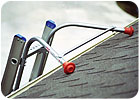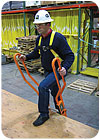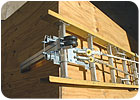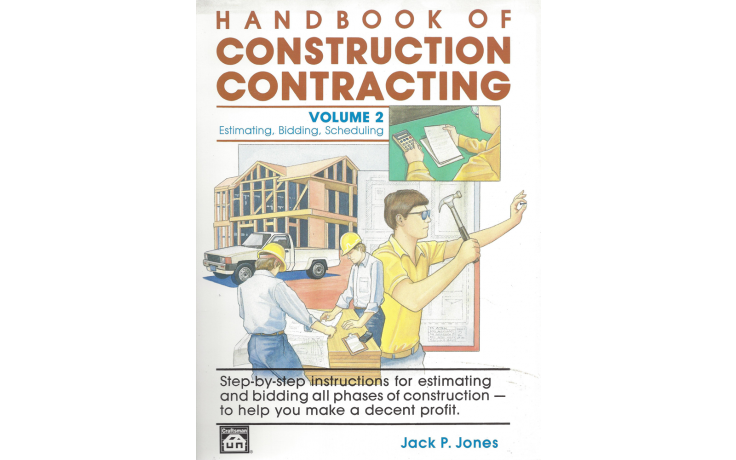
The fire services industry has always led the way in basic ladder innovations in this country, as the need for strength, stability and practicality in rescue situations is mandatory. Fires in highly combustible, tall buildings led to the invention of the Pompier ladder by Chris Hoell in 1880. Shaped like a question mark, the ladder could be used to scale the outside of a building. Using the Pompier by plunging the saw-toothed hook over he windowsill of the next floor, a firefighter could climb vertically to any height by pulling his ladder up and repeating the process to the next floor. Eighty years in use by the NYFD, the last Pompier was taken out of service in 1996 after saving countless lives.
In 1868, Joseph Winters invented the first wagon-mounted, fire escape ladder for immense sum of $3,000. Just eight years later the Dayhill-Hays Aerial Ladder Truck was patented, enabling firefighters to not only climb all the way up to the sixth floor (more than 75 feet) but to also rotate the ladder on a turntable base.
Since that time, people have continued to improve, modify and develop the concept of the portable ladder to more closely meet specific needs. Last month we reviewed three ladder innovations (see “A Brand-New Batch of Ladder Innovations - Part 1”). In this article, we’ll review three more. My evaluation criteria for a ladder innovation device included:
• Is the device entirely American-made?
• Is the device available anywhere in the United States?
• Is the device reasonably affordable for most roofers?
• Is the device designed to resolve a ladder problem previously unidentified or unsolved?
• Is the device relatively simple to assemble and use?
• Is the device able to take the everyday use and abuse doled out by the average American roofer?
My opinions apply only to my own use of the device on any particular day, under site-specific work conditions. You may be sure, however, though my opinion is only one in 300 million, you will get it loud and clear.

The Ladder-Max ladder stabilizer is designed to prevent damage to gutters, eaves, overhangs and metal siding. It features heavy-duty, non-marring, flexible plastic tips.
The Ladder-Max
Let me try and recall how many gutters I have crushed, repaired and then crushed again while setting up and/or climbing ladders to the roof in the past 40 years. On second thought, let’s not go there. There are more than a few ladder stand-off and/or stability devices out in the market today designed to eliminate the damage and mitigate the hazards involved with landing ladders near gutters, roofs and windows. As a matter of fact, Ladder-Max™ describes and compares a number of them on the company’s Web site, www.buyladder-max.com. I selected the patent-pending Ladder-Max to review because of its simplicity, its lightweight design, its ease of installation and its undeniable stability. I also like it for standing off of the fragile drip edges of slate roofs and aluminum roofs, both of which I have damaged, even with ladders equipped with foam rubber mitts. The point loads applied by the side rails of a typical 1A-40 foot ladder are fairly unforgiving and can cut like butter while the rhythm of climbing flexes the ladder. Many contractors I spoke with assume the repair cost liability at the ladder site as just another part of doing business. With the Ladder-Max, worrying about this problem is simply not necessary.The Ladder-Max, which has a suggested retail price of $59.95, is designed to fit all modern ladders manufactured after 1972 (and many made before). It will fit on both extension and single section straight ladders. It even fits on my Little Giant. The 16-gauge galvanized EMT arms are tied together with a 16-gauge galvanized cross arm EMT tube. The anti-torque bracket steps are “nested” over two consecutive rungs at the top of the ladder and are designed to be level when the ladder is set up at the required 75.5 degree angle.
The bottom step is fastened to the rung with 16-gauge heavy-duty galvanized steel, slip-resistant steps and locked into to lower rung using two zinc anodized, spring-steel loop pins. The manufacturer states that these pins do not contribute to product safety, as the Ladder-Max stabilizer is actually held in place by gravity when the climber loads the ladder. The pins are merely used to hold the stabilizer in place on the ladder during movement and placement of the combination.
The non-marring rubber safety tips actually provide four points of contact. All of the nuts are stainless steel Nyloc with stainless steel bolts and washers. The assembled stand-off arms incorporate both the arc and the wedge to maximize the device’s stability, providing a 40-inch wide span for the best stability with a 19-inch stand-off for room to work on the eaves.

Safe-T Ladder handrails allow for easy mounting and dismounting at the top the ladder.
• Another product that works just like it says it will - 100 percent satisfaction guaranteed.
• The instructions said it would take an average of 7 minutes to assemble with just a 7⁄16-inch box wrench. OK, so it took me almost 10 minutes. Once assembled, the Ladder-Max attaches and detaches from the ladder in just seconds, without tools. Contractors I lent it to tell me it really is a cinch to use and easily transfers between all of our ladders on the site.
• Because the Ladder-Max actually attaches to the rungs and not the side rails of the ladder, I am able to apply it to all of my ladders, including the Little Giant. It meets or exceeds OSHA/ANSI standards A14.1, A14.2, A14.5 and even the new A14.10 for Type IAA special duty 375 pound rating. It will attach to all modern wood, fiberglass, aluminum and articulated ladders.
• The device is a great stabilizer. I have de-iced plenty of roofs in the winter here in upstate New York, and I fully intend to use the Ladder-Max for the task this year. Although the tips may slide slightly on roof ice during installation, once the device is loaded with the climber’s weight, the 40-inch spread will resist that lateral “skate effect.” I’ll never enjoy de-icing, but now it won’t be so frightening.
• The “arc and wedge” principle of the Ladder-Max really does make a difference. I particularly like the way my ladder could be set up directly in a roof valley with the 40-inch span and rubber safety tips locking the ladder into the opposing planes.
• You just can’t beat the reasonable price.
Cons:
• The manufacturer of the Ladder-Max requires the ladder user to ensure there is at least 12 inches of structural surface on either side of the stand-off tips when used on roof or wall applications and a minimum of 12 inches of decking to the leading drip edge of the roof. While this is a reasonable safety factor to prevent accidental tip-over, it may preclude the use of the device in a few limited spaces. This is not really much of a problem. Just remember to keep your belt buckle between the side rails when reaching laterally.
• The climber is prohibited from standing above the lowest rung on which the Ladder-Max is attached. In most cases, this will be the second from the last rung, which is already an ANSI/OSHA prohibited step. If the device is attached at a lower rung location, the climber may not exceed the lowest attached rung. Under normal circumstances, however, this should not be a negative purchase factor. Competent ladder use always requires planning ahead.
• When the ladder is used as an access method to a roof, it must be extended at least 36 inches vertically above the discharge point. Depending on the roof pitch, I found that this will most likely place the lock-rung of the Ladder-Max on the fourth rung from the top. At this point I had to sidestep the ladder to dismount. I found the ladder was adequately stabilized for this maneuver, and the ladder attachment greatly enhanced the safety and convenience of the side-dismount.
The device works extremely well with the patented Safe-T Ladder handrails available through Guardian Fall Protection (www.guardianfall.com). When I reviewed this product for my 2005 “Ladder Innovations” article, it was known as the Walk-Through Railing System™ by American Innovations Corp. I was able to attach the device to the top of the ladder rails with the Ladder-Max stabilizer already attached in place. This combination made for an incredibly stable and safe means of stepping onto and off of the ladder without sidestepping. On one setup I added the Ladder Stability anchor to the subfascia. This combination resisted even my most violent attempts for lateral or horizontal ladder movement at the point and moment of discharge. While any one of these products would be a safe investment, in my opinion this marriage of equipment is “bombproof.”

The Portable Tether/Ladder Roof Anchor is designed to serve as a fall arrest/restraint device as well as a ladder roof anchor.
Portable Tether/Ladder Roof Anchor
I have to admit that the reason I initially chose to evaluate this device was because of the wonderful character who invented it, Mr. Berle Blehm. He is a timeless sort of entrepreneur/inventor with a bold sense of adventure built into every conversation. I’ve never met him face-to-face, but I’d better have a good night’s sleep and a big breakfast before I do. It is clear that the man knows ladders and roofs and the problems that can arise when one meets the other. He has been in mining and construction even longer than I have.The patent-pending Portable Tether™/Ladder Roof Anchor™ from Level Rite Ladder Safety Accessories (www.levelrite.net) first arrived as a box full of small parts. I admit it came across as a little “gimmicky” at first, but I attribute that to the first installation instructions I received. Let’s just say that these were still in development and could have used some clear photos or line drawings. In any case, it didn’t have so many moving parts that I had to return to school for an engineering degree in order to assemble it. Like everything else, once it’s built, you think, “What was so hard about that?”
Once assembled, I began to work with it and was duly impressed. The suggested retail price is $219.95. The Portable Tether/Ladder Roof Anchor is designed to serve as a fall arrest/restraint device as well as a ladder roof anchor. The manufacturer recommends installing the product at least 6 feet away from the unprotected gable end, as the fall arrest drop tests were performed with fall vectors toward the eave, not the gable end. The manufacturer also recommends the use of either a 3-foot or adjustable shock absorber lanyard when the device is used for the purpose of providing a personal fall arrest anchor for a single roofer, up to 310 pounds. Two roofers may use both lines for purposes of restraint or work positioning, in accordance to the OSHA Fall Protection standard. This will maintain a maximum 6-foot freefall should the climber potentially climb the roof pitch above his rope grab’s position. The portable tether should only be used by a worker on the same side of the ridge as the ladder.
The wheeled roof anchor makes vertically positioning a ladder on a roof ridge a simple and safe operation. It was tested in 2005 by the National Hose Testing Specialties Inc. to meet and exceed their standards. It is also approved by NFPA, replacing the sometimes risky use of a fireman’s ladder hook. It passed both static and dynamic ANSI drop load tests, even exceeding minimum requirements, according to Oregon OSHA officials who observed the testing.
The lightweight 6061-T6 aircraft aluminum product weighs less than 12 pounds. It attaches with simple U-bolts to the top two rungs of any extension ladder. It is adjustable to any roof pitch. I had to grapple with a 24-foot Class I fiberglass ladder in order to get in into the desired position. Later I wrangled an aluminum ladder into place with a fraction of the effort. I installed the Roof Anchor T-Bar™ ($14.95) with two rubber pads to straddle the convoluted valleys of my corrugated galvanized roofing on the opposite slope. This same device works well with standing seam, clay tile and slate roofs and easily clears and protects any built-up ridge vents by inches. While using Level Rite’s Portable Tether Roof Anchor as part of your site-specific personal fall arrest system design, compliance with 1926.500 (Subpart M-Fall Protection) is mandatory while working with this device. It is considered a supported scaffold (crawling board or “chicken plank”) under 1926.450 (Subpart L-Scaffold); therefore compliance with both OSHA construction standards is required, mandating the inspection and supervision of all equipment by an employer-designated competent person. Keep in mind this device is only suitable and approved by the manufacturer as a means of fall arrest/fall restraint anchorage for use on pitches equal to or greater than 12:12. The pitch-dialing device adjusts the roof anchor arm to any pitch from 5:12 up to 16:12. While the double foot ladder roof anchor attaches directly to the tether anchor plate on the opposite side of the roof, it is also assembled to the top two rungs of the extension ladder, where it may store within the ladder profile until needed. Two ANSI-approved 5⁄8-inch lifelines may be attached by carabiners to the anchor plate for fall arrest/positioning/restraint by attaching rope grab devices. One line may be used for PFAS while two may be utilized for positioning/restraint.

An optional accessory features cross arms and rubber feet that make the Ridge Anchor adjustable for all clay tile and metal roof profiles.
• When assembled according to the manufacturer’s instructions, this device is easy to install and dependable to use on any type of roof surface manufactured today. It took only two quick setups before I felt qualified to use this well-built and dependable product on any roof, anytime.
• I struggled a little bit at first with the installation of the Ladder Ridge Anchor. It is a rugged, professional and dependable device meant to protect roofers and “first men up.” It is no lightweight and should not be confused with simple “ridge hooks.” This device will not become accidentally dislodged and will not release from the ridge until intentionally removed. The more I used the Portable Tether Roof Anchor, the easier the operation became.
• Adjustable cross arms and rubber feet make the Ridge Anchor adjustable for all clay tile and metal roof profiles. It provides a suitable fall protection Portable Tether for all roofs at least 12:12 pitch. Caution is recommended that any and all roofers using the Portable Tether Roof Anchor are following their employer’s written OSHA/ANSI-compliant fall protection program. Their personal fall arrest system (PFAS) should be designed by a competent person using a job safety analysis (JSA), including logged equipment inspections pre-shift and regularly during use.
Cons:
• I’m not exactly the worst at assembling toys at Christmas, but I did have a minor mental struggle at first with these assembly instructions. I understand they are still being developed and edited. If this device were to be sold around the world, as it should, simple graphic, multi-lingual instructions to assemble and use would certainly improve sales. If it seems like I am being fussy, I probably am. The truth of the matter is, I am otherwise extremely satisfied with my Portable Tether/Roof Anchor. All of these “cons” really have more to do with my own inabilities rather than any shortcomings of the tool.
• My first installation was on a continuously corrugated galvanized roof panels. With a 2-inch center rib pattern it was important to pick the right wheel track I wanted the ladder to travel before flipping it over. Once my heavy fiberglass ladder reached 22 feet at the ridge, it was very difficult (or impossible) to move the ladder laterally. If the unit’s final position is critical, planning matters.
• When installing a long ladder (greater than 24 feet) on a bare CDX plywood (or OSB) roof decking, the smooth, hard plastic wheels had a tendency to slide sideways if I was careless in the operation. I am sure that softer, rubber wheels could have provided more traction in this procedure.
• The Ladder Roof Anchor comes with a single ladder anchor arm positioned on the opposite side of the ridge. The accessory Roof Anchor T-Bar ($14.95) is intended to spread the weight on metal roofs and fragile tile/slate roofs. I installed the T-Bar and use it on all ladder attachments. I think it should be the primary anchor device, as it is always on the ladder (not lost in a toolbox somewhere). It seemed to me to provide a greater feeling of lateral stability, especially when handling materials.
• The minimum roof pitch on which the roofer may safely use the Portable Tether Roof Anchor is 12:12 (a 45 degree slope). A warning decal should be clearly posted on the aluminum tether attachment plate stating this minimum pitch requirement. Likewise, a warning decal on the PFAS anchor plate requiring a competent person and compliance to the OSHA/ANSI standards would be advisable.
The Competent Person should be cautious when using the Portable Tether™ as an anchor point for PFAS on the roof. The roof pitch at the ridge must be 12:12 or steeper to be approved for fall arrest protection for a single roofer. I use my PTRA for brief excursions onto steep roofs for minor repairs. For more extensive steep roof work, I always use the PTRA for “first-man-up” operations in order to establish more permanent roof ridge anchors designed in my site-specific, OSHA-compliant residential fall protection program. The PTRA is a perfect solution to this initial hazardous exposure for well-trained, expert climbers initially accessing steep and extremely steep roofs.
When The PTRA is used for restraint/positioning operations for up to two roofers, be sure that the PFAS is designed to prohibit a freefall of more than 2 feet. Employee training, as always, is the key. Any attached roofer shall be trained in fall protection and equipped with a properly fit-tested ANSI-approved, full-body harness and attached to the lifeline/ rope-grab with a suitable, tear-out, shock-absorber lanyard.
The ladder must be located at a distance from the rake rafters to prevent the roofer from accessing and falling from the gable end of the roof. This device is designed to take the terminal impact force of one attached roofer in a vector down the roof slope only. It is also important to understand that this tether is only intended to be utilized on the side of the ridge on which the attached adder is installed.
All other aspects of an OSHA-compliant, site-specific fall protection plan should be completed. The setup, inspection and operation of this device should always be approved by an employer-designated competent person. Logged inspections should be made pre-shift, regularly during each shift and anytime the CP suspects the system has received any loads that could affect the unit’s structural integrity.
Like any PFAS anchor, any time the PTRA is involved in an arrested fall, be sure to tag it “out-of-service” and ship it back to the manufacturer for inspection, repair or replacement.

Still in the development stage, the Smart Ladder is designed to sense the weight applied to each leg of the ladder and set off audible and visual alarms if the ladder is out of balance.
The Smart Ladder
I have included the Smart Ladder™ in this article because of its intention rather than it’s execution, although they both still impress me. The inventor, Mr. Suresh Chandra, is a Columbia graduate laser physicist, recently retired from research at Science Applications International Corp. During his time there he received several optic laser patents. He first demonstrated his “ladder with electronic intelligence” at the Wright State University InventorFest in 2005. Chandra was motivated by a friend’s broken arm in a ladder tip-over accident to develop a ladder stability alarm system. He was also shocked by the 164,000 emergency medical treatments and $11 billion losses annually due to ladder accidents. The majority of the live and dead loads imposed on any extension ladder are transmitted to the ladder’s feet. Typically only a small quantity of the load is transmitted to the upper structural contact points.The Smart Ladder is an electronic device that attaches to any ladder and continuously monitors the ladder’s status relative to plumb line by sensing the weight applied to each leg of the ladder. This includes both he dead weight of the ladder and live weight of the climber. Sensors installed in the ladder feet compare the relative applied weights by measuring low-voltage circuit resistance and conductance.
The monitored conditions are fed back to the climber by three-stage audio and visual alarms generated by a 9-volt controller box. When the ladder is optimally balanced, whether loaded by climber’s weight or not, no auditory alarm is sounded and the green LED lamp is lit. Situations requiring caution are indicated by a yellow light and an alarm, and dangerous situations by a red light and an alarm. The alarm may also be wireless so it can be worn by the climber like a pager.
The risk/benefit analysis of the Smart Ladder device is obvious. Productivity is increased as the climber may work safely at the maximum potential of the ladder. Its installation will also ensure fewer lost-time accidents and injuries, thus greatly reducing those ladder-related workers’ compensation claims, which inevitably drive up the mod rates and cost of insurance. This device cannot be considered an engineering control method, as it does not actually prevent a ladder tip-over, thus removing the hazard. But as an administrative “early warning” hazard control method, it is certainly more effective than wearing PFAS designed to arrest a fall from an unstable ladder. This device is apparently still be in the developmental prototype stage and will undoubtedly become more adaptive, compact, attractive and inexpensive as the design becomes more refined. The controller will become miniaturized and the circuitry more compact and integrated in order to survive abusive conditions on the average construction site. The continuous stability monitoring of the ladder will assist in the awareness level of the user, alarming whenever the situation requires caution or is dangerous.
The Smart Ladder is an administrative hazard control device that differs from the engineering controls found in the other innovations in this article. It will not prevent the user from causing an accident while using a ladder, but rather warns users who are approaching an unstable condition. My personal field experience tells me that the portable extension ladder is a tool we often take for granted. The whole concept of marketing an early warning system appeals to me, as most construction workers are easily prone to tunnel vision, and hazard awareness can decrease as the workday wears on and our blood sugar gets low. I am confident with the advanced development of low-cost miniaturized circuitry we will all be encountering ladder hazard warning devices such as Mr. Chandra’s just as soon as the market discovers this prototype.
The American Inventor
In conclusion, I can only repeat my appreciation for the dedication and perseverance exhibited by these inventors. We all think about ways to make our jobs easier and safer, but only a few actually take the time and money required to see the process through countless prototypes and approvals until the final product becomes a reality.It has been my personal pleasure to consult with each one of the inventors during the compilation of this article. Keep up the good work. Which one of you reading this article will be next?



Report Abusive Comment